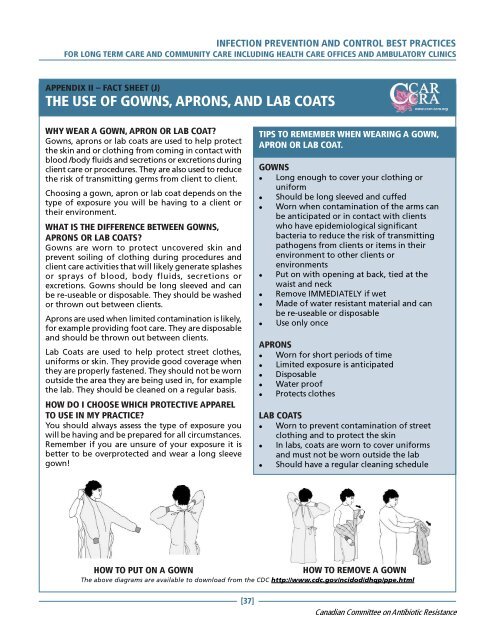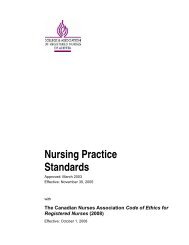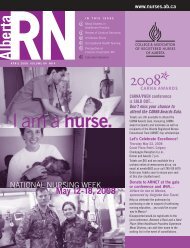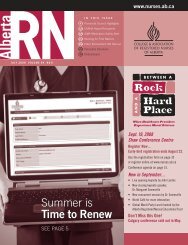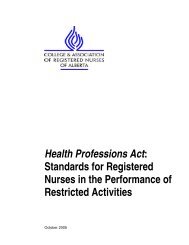Infection Prevention and Control Best Practices - College ...
Infection Prevention and Control Best Practices - College ...
Infection Prevention and Control Best Practices - College ...
Create successful ePaper yourself
Turn your PDF publications into a flip-book with our unique Google optimized e-Paper software.
INFECTION PREVENTION AND CONTROL BEST PRACTICES<br />
FOR LONG TERM CARE AND COMMUNITY CARE INCLUDING HEALTH CARE OFFICES AND AMBULATORY CLINICS<br />
APPENDIX II – FACT SHEET (J)<br />
THE USE OF GOWNS, APRONS, AND LAB COATS<br />
WHY WEAR A GOWN, APRON OR LAB COAT?<br />
Gowns, aprons or lab coats are used to help protect<br />
the skin <strong>and</strong> or clothing from coming in contact with<br />
blood /body fluids <strong>and</strong> secretions or excretions during<br />
client care or procedures. They are also used to reduce<br />
the risk of transmitting germs from client to client.<br />
Choosing a gown, apron or lab coat depends on the<br />
type of exposure you will be having to a client or<br />
their environment.<br />
WHAT IS THE DIFFERENCE BETWEEN GOWNS,<br />
APRONS OR LAB COATS?<br />
Gowns are worn to protect uncovered skin <strong>and</strong><br />
prevent soiling of clothing during procedures <strong>and</strong><br />
client care activities that will likely generate splashes<br />
or sprays of blood, body fluids, secretions or<br />
excretions. Gowns should be long sleeved <strong>and</strong> can<br />
be re-useable or disposable. They should be washed<br />
or thrown out between clients.<br />
Aprons are used when limited contamination is likely,<br />
for example providing foot care. They are disposable<br />
<strong>and</strong> should be thrown out between clients.<br />
Lab Coats are used to help protect street clothes,<br />
uniforms or skin. They provide good coverage when<br />
they are properly fastened. They should not be worn<br />
outside the area they are being used in, for example<br />
the lab. They should be cleaned on a regular basis.<br />
HOW DO I CHOOSE WHICH PROTECTIVE APPAREL<br />
TO USE IN MY PRACTICE?<br />
You should always assess the type of exposure you<br />
will be having <strong>and</strong> be prepared for all circumstances.<br />
Remember if you are unsure of your exposure it is<br />
better to be overprotected <strong>and</strong> wear a long sleeve<br />
gown!<br />
[37]<br />
TIPS TO REMEMBER WHEN WEARING A GOWN,<br />
APRON OR LAB COAT.<br />
GOWNS<br />
� Long enough to cover your clothing or<br />
uniform<br />
� Should be long sleeved <strong>and</strong> cuffed<br />
� Worn when contamination of the arms can<br />
be anticipated or in contact with clients<br />
who have epidemiological significant<br />
bacteria to reduce the risk of transmitting<br />
pathogens from clients or items in their<br />
environment to other clients or<br />
environments<br />
� Put on with opening at back, tied at the<br />
waist <strong>and</strong> neck<br />
� Remove IMMEDIATELY if wet<br />
� Made of water resistant material <strong>and</strong> can<br />
be re-useable or disposable<br />
� Use only once<br />
APRONS<br />
� Worn for short periods of time<br />
� Limited exposure is anticipated<br />
� Disposable<br />
� Water proof<br />
� Protects clothes<br />
LAB COATS<br />
� Worn to prevent contamination of street<br />
clothing <strong>and</strong> to protect the skin<br />
� In labs, coats are worn to cover uniforms<br />
<strong>and</strong> must not be worn outside the lab<br />
� Should have a regular cleaning schedule<br />
HOW TO PUT ON A GOWN HOW TO REMOVE A GOWN<br />
The above diagrams are available to download from the CDC http://www.cdc.gov/ncidod/dhqp/ppe.html<br />
Canadian Committee on Antibiotic Resistance


